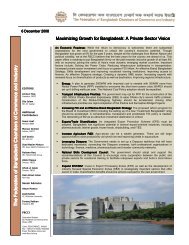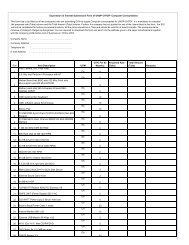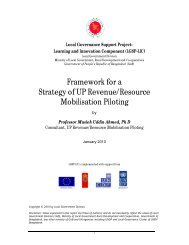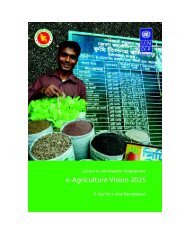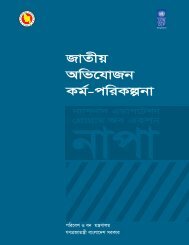The probable impacts of climate change on poverty - UNDP
The probable impacts of climate change on poverty - UNDP
The probable impacts of climate change on poverty - UNDP
You also want an ePaper? Increase the reach of your titles
YUMPU automatically turns print PDFs into web optimized ePapers that Google loves.
during the m<strong>on</strong>th <str<strong>on</strong>g>of</str<strong>on</strong>g> June, July and August. On the other hand annual average rainfall for Rangpur is 2270 mm <str<strong>on</strong>g>of</str<strong>on</strong>g><br />
which 1294 mm occurs during the m<strong>on</strong>th <str<strong>on</strong>g>of</str<strong>on</strong>g> June, July and August.<br />
It is found from the analysis that number <str<strong>on</strong>g>of</str<strong>on</strong>g> days without rainfall in Bogra stati<strong>on</strong> is showing an increasing trend<br />
while total annual rainfall is showing decreasing trend. It is also to be noted that the <str<strong>on</strong>g>change</str<strong>on</strong>g> is not significant and<br />
relati<strong>on</strong>ship is not very str<strong>on</strong>g. It is found from the analysis that both number <str<strong>on</strong>g>of</str<strong>on</strong>g> days without rainfall and annual<br />
total rainfall in Rangpur is increasing, which means more rain is occurring in short durati<strong>on</strong>. It also reflects erratic<br />
behaviour <str<strong>on</strong>g>of</str<strong>on</strong>g> rainfall. It is also to be noted that the <str<strong>on</strong>g>change</str<strong>on</strong>g> is not significant and relati<strong>on</strong>ship is not very str<strong>on</strong>g.<br />
Figure 3.2 shows <str<strong>on</strong>g>change</str<strong>on</strong>g>s in annual rainfall and days without rainfall with their trend in Rangpur Stati<strong>on</strong>.<br />
Figure 5.1 Change in Trend <str<strong>on</strong>g>of</str<strong>on</strong>g> Annual Rainfall and Days-without Rain (Rangpur Stati<strong>on</strong>)<br />
Days without Rainfall<br />
300<br />
280<br />
260<br />
240<br />
220<br />
200<br />
180<br />
160<br />
140<br />
120<br />
100<br />
1972<br />
1973<br />
1975<br />
1976<br />
1977<br />
1978<br />
1979<br />
5.2.2 Future Climate Change Scenario<br />
General Circulati<strong>on</strong> Model (GCM) and Providing Regi<strong>on</strong>al Climates for Impacts Studies (PRECIS) have been run to<br />
develop future <str<strong>on</strong>g>climate</str<strong>on</strong>g> <str<strong>on</strong>g>change</str<strong>on</strong>g> scenarios for Bangladesh. <str<strong>on</strong>g>The</str<strong>on</strong>g> GCM is a global scale model where PRECIS is a<br />
regi<strong>on</strong>al scale model. Both models output indicate a steady increase in temperatures al<strong>on</strong>g with increased trend<br />
<str<strong>on</strong>g>of</str<strong>on</strong>g> summer m<strong>on</strong>so<strong>on</strong> precipitati<strong>on</strong> with higher level <str<strong>on</strong>g>of</str<strong>on</strong>g> inter seas<strong>on</strong>al variability. Global Circulati<strong>on</strong> Model (GCM)<br />
predicts an average temperature increase <str<strong>on</strong>g>of</str<strong>on</strong>g> 1.0ºC by 2030, 1.4ºC by 2050 and 2.4ºC by 2100. <str<strong>on</strong>g>The</str<strong>on</strong>g> results also<br />
revealed somewhat more warming during the winter m<strong>on</strong>ths than during the summer. GCM also estimates that<br />
precipitati<strong>on</strong> will increase between 6 to 12% during m<strong>on</strong>so<strong>on</strong> m<strong>on</strong>ths (June, July and August) in 2030 and 2100<br />
respectively while small decreases in the winter m<strong>on</strong>ths (December, January and February) also predicts.<br />
However, value <str<strong>on</strong>g>of</str<strong>on</strong>g> standard deviati<strong>on</strong> from mean suggests that <str<strong>on</strong>g>change</str<strong>on</strong>g>s are not statistically significant (Agrawala<br />
et al., 2003).<br />
<str<strong>on</strong>g>The</str<strong>on</strong>g> PREICS model result shows that temperature (maximum and minimum) and rainfall vary over space and<br />
time. Value <str<strong>on</strong>g>of</str<strong>on</strong>g> some m<strong>on</strong>ths is much higher than the seas<strong>on</strong> or annual average. Annual average <str<strong>on</strong>g>of</str<strong>on</strong>g> maximum<br />
temperature show an increasing trend but shows that increase over time will decline while minimum<br />
temperature shows gradual increase over time. Projecti<strong>on</strong> shows that rainfall in m<strong>on</strong>so<strong>on</strong> and post-m<strong>on</strong>so<strong>on</strong><br />
seas<strong>on</strong>s will increase while rainfall in the dry seas<strong>on</strong> will remain closer to historical amount. Rainfall in prem<strong>on</strong>so<strong>on</strong><br />
shows erratic nature. It predicts that rainfall will increase about 4, 2.3 and 6.7 percent in 2030, 2050 and<br />
2070 respectively in reference to the observed baseline period 1961-1990 (BUET, 2008). Table 5.1 shows summary<br />
<str<strong>on</strong>g>The</str<strong>on</strong>g> Probable Impacts <str<strong>on</strong>g>of</str<strong>on</strong>g> Climate Change <strong>on</strong> Poverty and Ec<strong>on</strong>omic Growth and<br />
the Opti<strong>on</strong>s <str<strong>on</strong>g>of</str<strong>on</strong>g> Coping with adverse Effect <str<strong>on</strong>g>of</str<strong>on</strong>g> Climate Change in Bangladesh<br />
1980<br />
y = 0.4483x + 247.86<br />
R 2 = 0.0282<br />
y = 12.565x + 2067.6<br />
R 2 = 0.041<br />
1982<br />
1983<br />
1984<br />
1985<br />
1986<br />
1987<br />
1988<br />
1989<br />
1990<br />
1991<br />
1992<br />
1993<br />
1994<br />
1995<br />
1996<br />
1997<br />
1998<br />
1999<br />
2000<br />
Days without Rain Annual Total<br />
Linear (Annual Total) Linear (Days without Rain)<br />
2001<br />
2002<br />
4000<br />
3500<br />
3000<br />
2500<br />
2000<br />
1500<br />
1000<br />
500<br />
Rainfall in mm<br />
27




